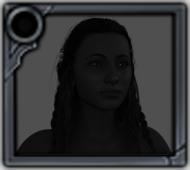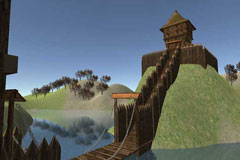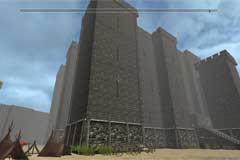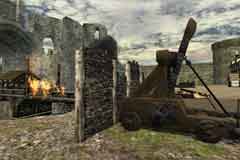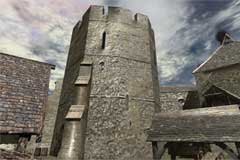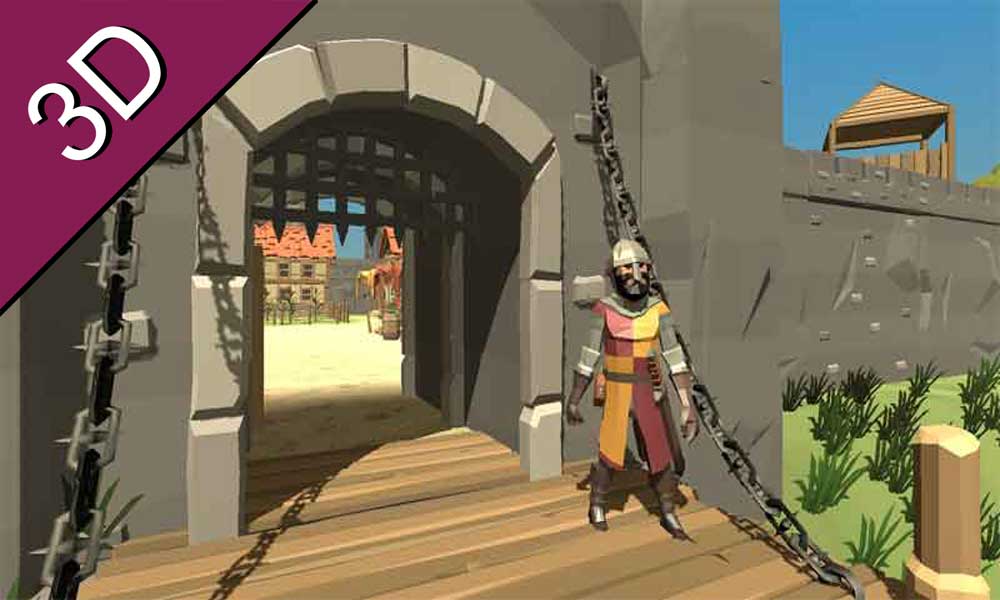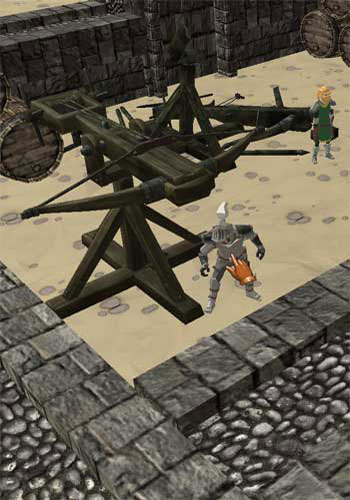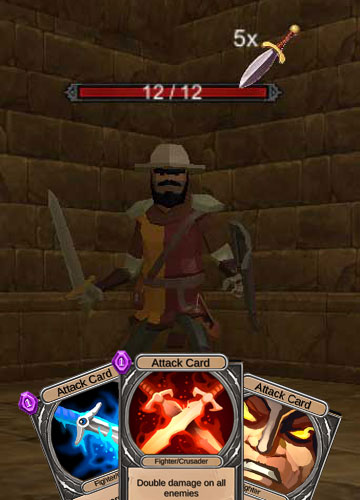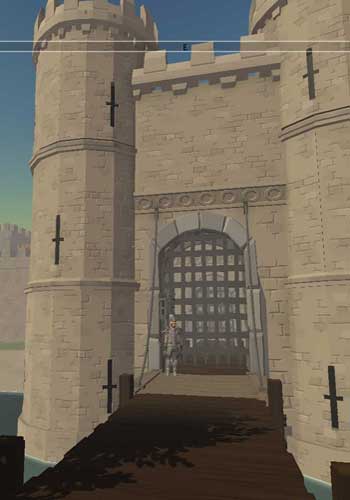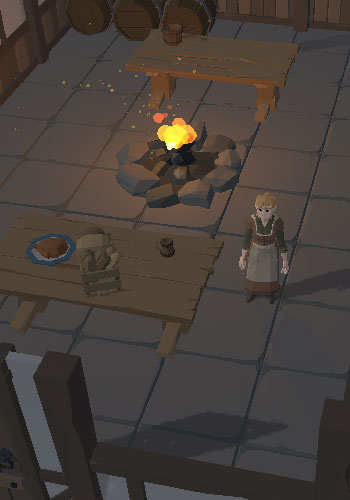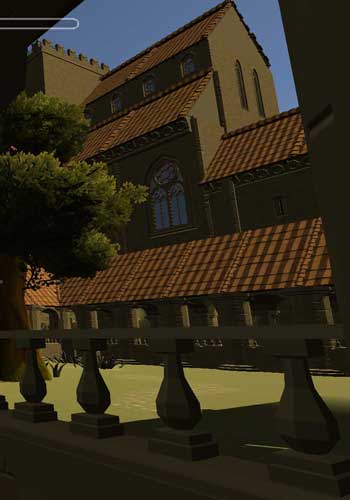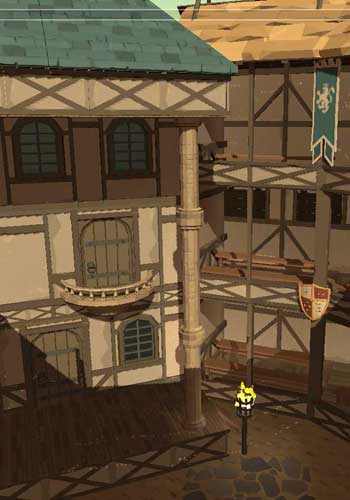 eorge Plantagenet was born in Dublin on the 21st October 1449. He was the 3rd surviving son of Richard, Duke of York and Lady Cecily Neville. At the time his father was Lord Lieutenant of Ireland. Later they returned to Fotheringhay, which became home during his growing up. Three years later his brother Richard was born, the child who become Richard III.
eorge Plantagenet was born in Dublin on the 21st October 1449. He was the 3rd surviving son of Richard, Duke of York and Lady Cecily Neville. At the time his father was Lord Lieutenant of Ireland. Later they returned to Fotheringhay, which became home during his growing up. Three years later his brother Richard was born, the child who become Richard III. When he was ten, the two brothers were moved to Ludlow Castle, as it was decreed by the Duke of York that the castle at Fotheringhay was not secure enough in those troubled times. The Duchess of York, joined them at Ludlow a few days later. The eldest sons of the York family, Edward, Earl of March and Edmund, Earl of Rutland, had grown up and been taught all the arts and skills of being knights and belted earls at Ludlow. George had not, up to that time, met his two brothers. No portrait of Edmund, Earl of Rutland, exists, but it is probably fair to assume he too was good-looking. In later years the same thing was written about George.
By the end of summer the King's army was advancing on the town, the Yorks were out numbered, so it was decided that Richard Duke of York and the two eldest Yorks should leave immediately, in order to fight another day, and that Lady Cecily and the two youngest boys should surrender to the king's army. The Duke rode away under cover of the night and the next morning the soldiers took charge of the duchess and her two sons, conveying them to her sister's home in Coventry, whilst the rest of the army sacked the village and the castle.
It could not have been a particularly happy time, being in the care of a complete stranger, but it did not last too long. Edward was in Calais, preparing for a return and thinking of his younger brothers too, as he arranged for them to be removed to the Archbishop of Canterbury's home, where they could be educated.
June 1460 and a change in the fortunes of the House of York. The Earls of Warwick, Salisbury and March, together with Lord Falconberg, were back in England, where they fought and won the Battle at Northampton. In October of that year the Yorks were reunited in London.
The triumph did not last. By the end of the year, the disastrous Battle of Wakefield had claimed the lives of Richard, Duke of York, Edmund, Earl of Rutland and the Earl of Salisbury. The Duke's head was cut off and put on a spike at Micklegate, adorned with a paper crown, signifying his claim to the English throne and its disastrous consequences. Edmund, Earl of Rutland, aged 17, was killed on the battlefield in cold blood.
George and Richard were despatched to Burgundy for safety until the situation in England was resolved. The two boys were greeted and treated with great reverence, then quietly removed to Utrecht where their education was resumed. They were not allowed to leave for England before the political situation had settled, which basically meant that they had to wait until their brother Edward was about to be crowned as King. When that news came, the boys were féted and treated as honoured royal guests, showered with gifts and compliments before they returned to England.
The new king, Edward IV, created his younger brother George Steward of England for the coronation. Shortly after that, George Plantagenet became Duke of Clarence, a title that showed he was Edward's heir. He was made Knight of the Bath and a short time later Knight of the Garter, a high honour which confirmed his future role in life: a land owning magnate and heir to the throne. He was not yet 12 years old.
At seventeen, George, Duke of Clarence was said to be handsome, tall and charming. His Lieutenantship of Ireland was given to a deputy, the Earl of Worcester, as Edward refused to let him go because of his young age but he had many duties, acting as commissioner and steward on important occasions. It was about this time that the first difficulties arose. Edward IV had showered responsibilities and honours on Richard, whereas George, three years older, had none. In his fury he made a fuss to the extent that Edward had to reverse the decision and allocate them to George. It did not bode well for the future.
- In September 1464 George Duke of Clarence heard the news of the marriage of Edward IV and Elizabeth Grey. Immediately his position as Edward's heir was wiped out. It left him sidelined, which may have accounted for what happened next in his life. Warwick and Clarence were first cousins, with a twenty year age gap between them. A friendship was soon developing, as George was looking to the future and marriage to Isabel, the Earl's oldest daughter. That marriage would secure George's future with estates and wealth and keep the patronage of a powerful earl. It is possible that George did not see anything wrong in making an alliance with Warwick, who had been loyal to Edward IV, despite rumours of pro-Lancastrian plots. Warwick could no doubt see the sense in cultivating the brother of the king and binding him to the family by marriage. The problems began when Edward vetoed the arrangement. Clarence took serious objection to his brother's opposition and decided to go ahead with the marriage anyway. They made the arrangements and travelled to Calais in 1469. There Archbishop Neville conducted the wedding ceremony. George, Duke of Clarence became a part of the Warwick empire.
- Just before travelling to Calais, Warwick had written to Coventry and other places with an array, saying he was going to subdue the northern rebels. The truth was he planned to use the men in his own insurrection. When they returned to England, they launched the Battle of Edgecote which ended with Clarence, working with Warwick, ordering executions, surely a taste of real power. When his brother Edward IV was taken prisoner by Archbishop Neville and handed over to Warwick and Clarence himself, it must have seemed like the ultimate in power. It is this act which many cite as the real treachery of Clarence against his brother Edward IV.
- Edward outsmarted them, however, and, surrounded by several hundred armed men, calmly left his captivity and returned to London to claim his crown again. He appeared not to hold a grudge against his brother and the Earl as he began to negotiate to bring them back into the court again. This may not have pleased his new Queen or her family, the Woodvilles, but Edward was the supreme ruler and what he said happened.
- Unfortunately the moves did not work. Another uprising ended with Clarence and Warwick suffering an enforced exile to Calais, Clarence with his heavily pregnant wife who gave birth to a stillborn son. To add to his miseries, Clarence had to stand back and watch his sister-in-law being married to the Prince of Wales and realise that all his ambitions were as nothing in the eyes of the Kingmaker.
- It can only be presumed but seems likely that it was at this time Clarence secretly began his moves to reinstate himself with the king and having land and estates returned to him. Edward must have wanted his brother back in the family, or surely he would not have given him such favours after his blatant treachery. Trading on Edward's good nature, Clarence asked for concessions for Warwick too, which were offered.
- Unfortunately for Warwick, he did not appear to be able to accept Edward's offers. He raised an army and on the 14th April, the Battle of Barnet took place. Warwick was cut down, despite orders from both Edward and Clarence that he be allowed to live. Clarence no longer had a strong ally outside the Yorks.
- On the 4th May Battle of Tewkesbury took place and the Prince of Wales was killed. It is suggested by some that it was Clarence who did the deed but it has never been proved. This meant Anne Neville was a widow after the briefest of marriages and left her as a desirable heiress for someone. She had long been coveted by Richard Duke of Gloucester.
- Richard asked for the hand of Anne Neville in marriage. For reasons best known to himself George did not agree. Richard immediately went to Edward, and asked that she be released into his care. George's reaction was to try to disguise her and hide her in a friend's home. It didn't work; in the shortest possible time Richard had discovered her whereabouts and had her escorted to sanctuary at St Martins in the Field until he could arrange the marriage.
The Earl's death had left a legacy of wealth and disputes behind it. The inheritance argument went on for years, with brother against brother, adjudicated by the king, surely a most fascinating combination. Both men, Clarence and Gloucester, were versed in law and skilled in the art of oratory and their legal arguments were admired by many, a fact which did not make it easy for Edward IV to make a fair or easy judgement over the cases. In fact, Clarence had no legal standing to forbid Anne Neville's marriage to his brother as he was not her guardian and the Countess was still alive. But eventually a compromise was reached, the marriage was agreed but the division of the Warwick estates was uneven, with a greater proportion going to Clarence and Gloucester giving up the office of Great Chamberlain.
That wasn't the end of the disputes, though. They continued to flare up, especially when the Countess of Warwick was released from sanctuary, as it threatened to depose Clarence of some of his estates. As arguments broke out yet again, giving Edward no choice but to create an act of resumption which took from Clarence everything he had. He was left with a stark choice: rebellion or submission. He chose to submit and paved the way for a new act which authorised both Dukes to divide the property of the Countess and thus end that particular problem once and for all.
Clarence's wife, Isabel, died in December 1476. Some reports are that she died of childbirth complications, others that she suffered from T.B. and simply wasted away. This seems the most likely as her sister, Anne Neville, Duchess of Gloucester, was to die of the same condition later. In his wild grief, Clarence made an attempt to arrange a marriage with the daughter of the late Duke of Burgundy,. This was immediately blocked by Edward.
From that time on, Clarence's actions became hysterical. He left the court and retired to his country estate. If he ever went to see Edward for any reason, he refused meat and drink, as if suspecting people of wanting to poison him. He had no pleasant words for anyone, but frowned as if everyone was against him.
Earl Rivers was proposed as a candidate for marriage with Mary in Burgundy. Whether this was the final straw for a mind in danger of going over the edge, history does not say, but he began investigating and questioning and eventually convinced himself that his wife's servant, Ankarette Twynho, had poisoned his wife. He also accused another member of his household, John Thursby, of poisoning his infant son. Ankarette and John Thursby were brought before the justices at Warwick. The trial was rigged, they were found guilty and they were hanged. Edward, in what would appear to be retaliation, had a member of Clarence's household, one John Stacey, accused of witchcraft and executed. Clarence's response was to appear in council at Westminster where he insisted they listened to a priest read John Stacey's declaration of innocence. The net result of this confrontation was Clarence being arrested on the orders of the king. It would seem his behaviour had finally upset the Woodvilles to the point when they put pressure on the king to do something about a troublesome Duke.
It is said by some historians that Clarence knew of the pre-contract of marriage that Edward had entered into. This is another of history's great unanswered questions, how much did he know? Suddenly things seemed to get out of hand. The execution of Thomas Burdett on a charge of necromancy was meant to be a warning to Clarence, but it didn't work. He gathered men around him, accused his brother the king of the black arts, broadcast the 'fact' that Edward was a bastard and cast doubts on the validity of the royal marriage. None of this could be ignored, particularly when the final piece fell into place, the 'statement' that Clarence had sought the hand of Mary as a means of seizing the throne.
Clarence was summoned to appear before the king, which he did, and was committed to the Tower. It was Christmas and the court was celebrating, but it has been recorded that Richard Duke of Gloucester spent the time pleading for his brother's life. On the 15th January 1478 the wedding of the Duke of York and Anne Mowbray was celebrated. The next Parliament convened to try George Duke of Clarence for high treason. It was said no one accused the Duke but the King and no one answered the accusations but the Duke. Everything that could have been said in mitigation had been said over the Christmas period and had no effect at all. On the 7th February sentence of death was passed, but even then Edward stayed his hand. He waited ten days but eventually, on the 18th February 1478 the sentence was carried out privately within the walls of the Tower of London.
It has come down through history that Clarence was executed by being drowned in a butt of malmsey wine. There is no evidence for this, it is highly possible that it was a myth that attached itself to his name. It is more likely that, because of his love for the wine, which he drank to excess most of the time, someone commented that he had in fact drowned in malmsey wine and the story stuck. It is more likely that he was quietly drowned in his bath, as one contemporary record has it, and he was buried at Tewkesbury Abbey along with his wife, Isabel Neville.

